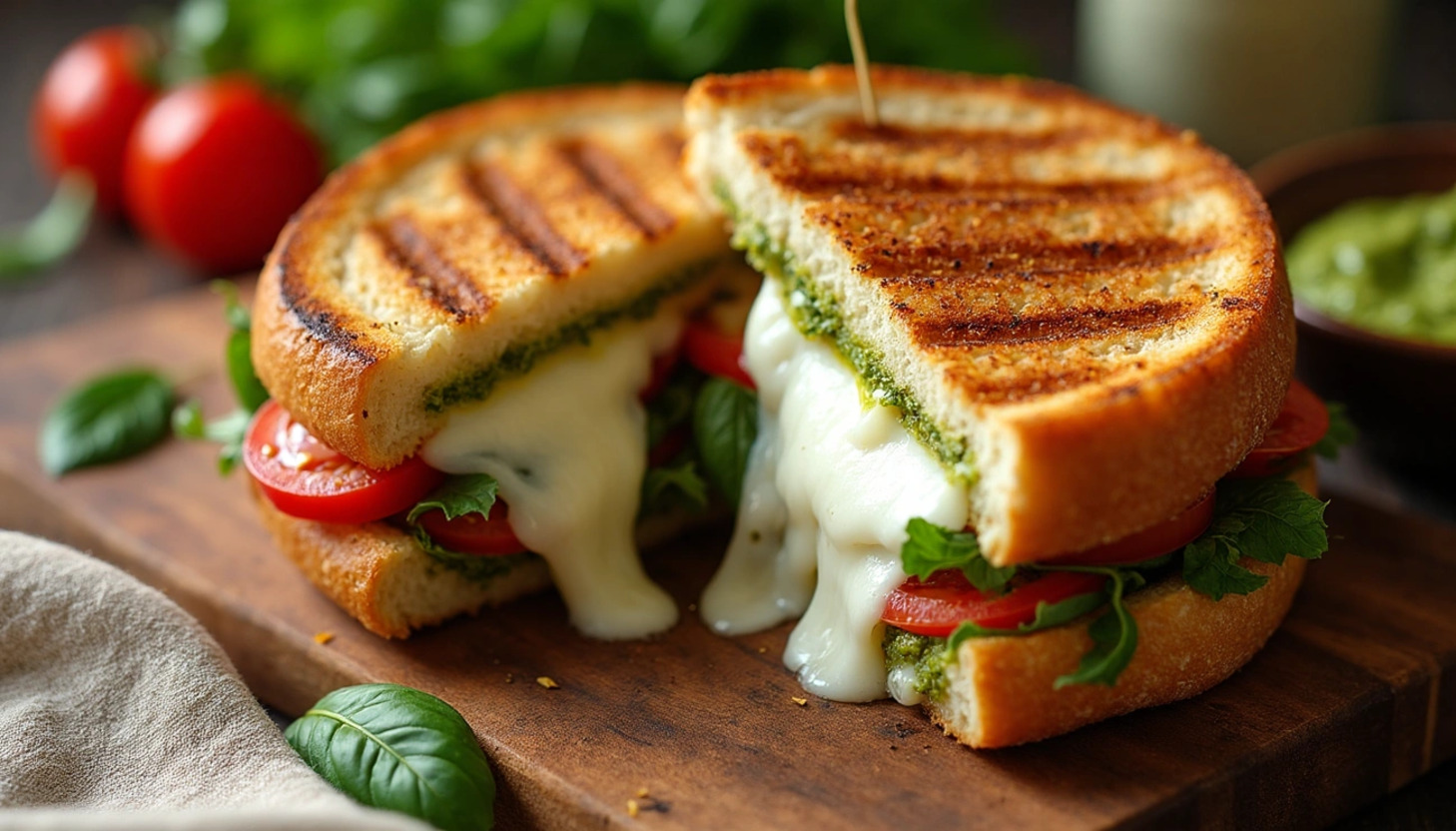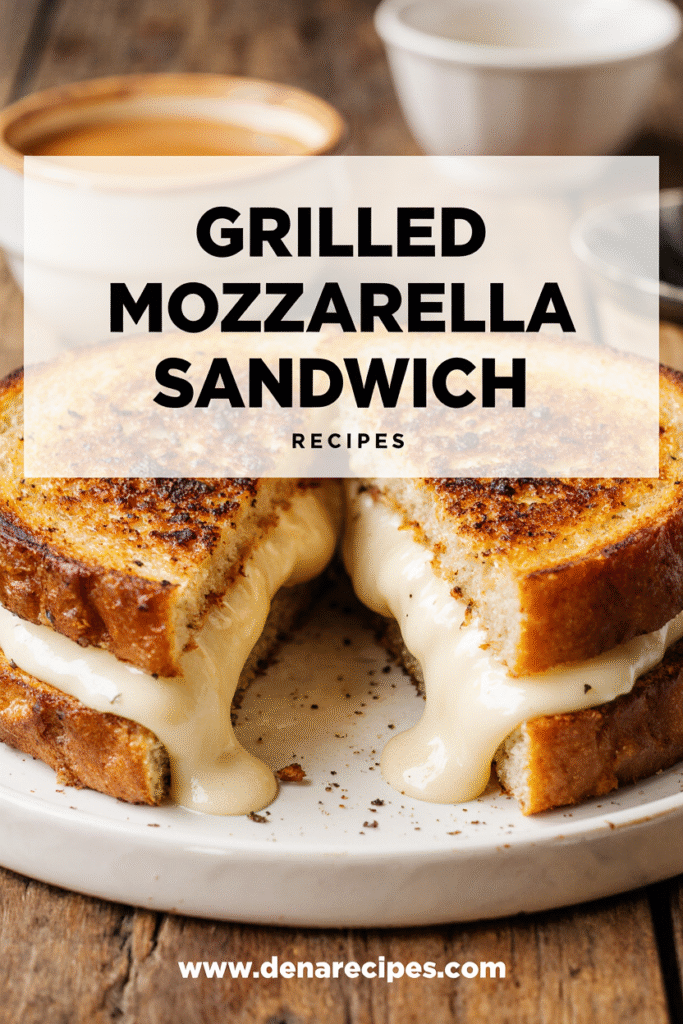The Perfect Grilled Mozzarella Sandwich: A Chef’s Secret Recipe Guide
Gooey, melty, and utterly irresistible—a grilled mozzarella sandwich delivers one of life’s simple yet profound culinary pleasures. When I bite into that perfect combination of golden-crisp bread and stretchy cheese, I’m reminded why this classic comfort food never goes out of style. Prepare yourself for an epic cheese pull that satisfies both visually and gastronomically!
What makes the mozzarella grilled cheese sandwich special is its versatility and healthier profile compared to many store-bought alternatives. At under 450 calories per sandwich, it offers a reasonable indulgence without excessive guilt. Additionally, making your own pesto for the sandwich eliminates unnecessary preservatives and additives commonly found in commercial versions. When tomatoes are in season, there’s nothing quite like combining them with just a few quality ingredients to create a caprese grilled cheese sandwich that truly lets the summer flavors shine. In this guide, I’ll share my chef-tested secrets for crafting the perfect grilled mozzarella and tomato sandwich, complete with variations like adding prosciutto or creating a gluten-free version that still melts in your mouth.
Choosing the Right Ingredients for a Grilled Mozzarella Sandwich
Creating an extraordinary grilled mozzarella sandwich starts with selecting the perfect ingredients. The quality of each component dramatically influences the final result, transforming a simple sandwich into a memorable meal.
Best type of mozzarella to use
Fresh mozzarella offers a superior experience for your grilled sandwich. Unlike its low-moisture counterpart, fresh mozzarella (typically sold in water) delivers a clean, milky flavor that serves as an excellent canvas for other ingredients. This style of Italian cheese belongs to the ‘pasta filata’ or ‘stretched curd’ family, which explains its impressive meltability. Furthermore, the heating and stretching process gives mozzarella its “muscle memory” for stretching when heat is applied again.
For the ultimate melt, consider buffalo mozzarella or fiore de latte cheese packed in milky whey for the creamiest flavor. However, if you’re prioritizing a stretchier, less watery sandwich, you might want to combine fresh mozzarella with a more flavorful cheese like vintage cheddar or gruyere. Remember that pre-grated cheese contains anti-caking agents that prevent proper melting, so always grate your own.
Bread options that hold up well
The ideal bread for a grilled mozzarella sandwich should be sturdy yet soft, with medium thickness (about 1/4 inch). Sourdough bread makes an excellent choice, offering a slight tanginess that beautifully balances the richness of cheese and butter. Alternatively, brioche provides a soft, buttery base, though it browns more quickly due to its egg and sugar content.
For a classic approach, white sandwich bread works wonderfully because its uniform thickness ensures even heat distribution. Regardless of your choice, avoid bread with large air holes that might create cheese-escape routes.
Fresh add-ons: tomatoes, basil, and more
Ripe tomatoes are essential for a Mediterranean-inspired sandwich. Look for firm, juicy varieties like Beefsteak or heirloom tomatoes when they’re in season. Slice them about 1/4-inch thick to maintain the perfect bread-to-filling ratio.
Fresh basil leaves provide that signature aromatic quality that elevates your sandwich. Large-leaf varieties work best, with 8 leaves creating the perfect amount of flavor. For additional depth, add a teaspoon of pesto to your bread before layering other ingredients.
Optional extras: roasted peppers, prosciutto, artichokes
To truly customize your grilled mozzarella sandwich, consider these gourmet additions. Thinly sliced prosciutto di Parma offers a delightful salty contrast, while marinated artichoke hearts bring a tangy dimension. Roasted red peppers provide the perfect balance to sharp cheeses and salty prosciutto.
For a complete Mediterranean experience, incorporate a combination of these extras. Since mozzarella itself is quite mild, these additional ingredients create layers of flavor that transform a simple sandwich into a culinary adventure.
How to Make the Perfect Pesto Spread
A flavorful spread can turn an ordinary grilled mozzarella sandwich into something truly exceptional. Pesto, with its vibrant color and aromatic profile, serves as the perfect flavor enhancer for your next cheese masterpiece.
Classic basil walnut pesto
While traditional pesto calls for pine nuts, walnuts make an excellent substitute that’s both economical and flavorful. In fact, walnuts cost about a quarter of the price of pine nuts, with a 40oz bag of walnuts running around $20 compared to $26 for just 16oz of pine nuts.
To create this wallet-friendly pesto, toast your walnuts in a dry skillet until golden brown—about 7 minutes. Then in a food processor, combine 2 cups fresh basil leaves, garlic cloves, toasted walnuts, grated Parmigiano-Reggiano, salt, pepper, and 2 tablespoons of olive oil. With the processor running, slowly drizzle in remaining olive oil until the mixture reaches a smooth consistency. For the brightest green color, add a cup of fresh parsley alongside your basil.
Lemon basil mayo alternative
For a lighter, tangier spread option, lemon basil mayo delivers exceptional results. This sauce feels surprisingly light despite being mayo-based, with lemon providing a refreshing kick that balances the richness of cheese and bacon in your sandwich.
To prepare, simply combine 1 cup mayo, 2 garlic cloves, ¼ cup lemon juice, 1 cup fresh basil leaves, and a pinch of salt and pepper in a food processor. Pulse until fully combined. Fresh basil is non-negotiable here—jarred basil pesto makes an acceptable substitute if fresh leaves aren’t available, but dried basil simply won’t provide enough flavor.
Store-bought vs homemade pesto
Consequently, the question arises: is making your own pesto worth the effort? Price-wise, homemade pesto typically costs around $0.60 per ounce, whereas store-bought options from grocery stores run approximately $0.50 per ounce. Bulk options from warehouse stores offer even better value at roughly $0.36 per ounce.
Beyond price, freshness is paramount—homemade pesto keeps only 2-3 days in the refrigerator. Moreover, in blind taste tests, homemade pesto consistently delivers superior flavor, though restaurant-made options sometimes edge out homemade versions. For weeknight convenience, quality store-bought brands like Buitoni (containing no preservatives) work perfectly well.
Step-by-Step: Assembling and Cooking the Sandwich
The assembly process marks the moment when individual ingredients transform into sandwich artistry. Let’s explore the techniques that elevate a simple grilled mozzarella sandwich into a masterpiece of texture and flavor.
Layering the ingredients properly
Initially, smear the interior of your bread slices with pesto or your chosen spread. Place a layer of sliced tomatoes on one slice, season with fresh pepper, then arrange mozzarella slices on top. To ensure proper melting, use freshly grated cheese rather than pre-shredded, as the anti-caking agents in packaged shredded cheese inhibit proper melting. Once your ingredients are stacked, close the sandwich with the second slice of bread.
Using a skillet, panini press, or oven
Each cooking method offers unique advantages. For stovetop preparation, a heavy cast-iron skillet over medium-low heat works beautifully. Place the sandwich in the preheated skillet and press down lightly with a spatula or add another heavy pan on top to create a makeshift press. For panini press users, preheat to about 325°F or medium heat, place your assembled sandwich inside, and gently lower the lid. Alternatively, the oven method creates an impressive result by preheating one baking sheet, placing sandwiches between two sheets, essentially creating a giant panini press.
How to get the perfect golden crust
As a matter of fact, mayo rather than butter often creates a superior golden crust with better browning. This happens because mayo has a higher smoke point and the combined browning power of oil and egg yolks. For buttered sandwiches, soften the butter completely before spreading to ensure even coverage. Cooking time should be approximately 3-5 minutes per side, throughout which you should maintain medium-low heat—rushing with high heat risks burning the bread before melting the cheese.
Melting mozzarella evenly
To achieve that perfect, Instagram-worthy cheese pull, cook your sandwich at a lower temperature than you might expect. This gives the cheese time to melt completely before the bread burns. Above all, resist checking too frequently—opening the press or flipping too soon can disrupt the melting process. If you notice the bread browning too quickly while the cheese remains solid, lower the heat immediately and consider covering the skillet with a lid to create steam that helps melt the cheese from above.
Tips, Variations, and Common Mistakes to Avoid
Mastering the perfect grilled mozzarella sandwich requires attention to detail and knowing how to sidestep common mistakes. These professional tips will elevate your sandwich game while offering creative variations to suit different dietary needs and taste preferences.
Avoiding soggy bread
The enemy of any grilled cheese is sogginess. To prevent this, cool your sandwich on a wire rack after cooking, allowing air to circulate underneath rather than trapping steam between the sandwich and plate. Alternatively, place your sandwich on parallel chopsticks to create a mini cooling rack that prevents condensation buildup. For tomato-based sandwiches, pat tomato slices dry with paper towels before assembly. Pre-toasting your bread before adding ingredients also creates a moisture barrier, especially important when using fresh mozzarella.
Making it gluten-free or vegetarian
Fortunately, converting your sandwich to accommodate dietary restrictions is straightforward. For gluten-free versions, lightly toast gluten-free bread before assembling to improve texture and prevent it from absorbing excess moisture. Brands like Bread SRSLY sourdough work exceptionally well for grilled sandwiches. Vegetarian options are naturally abundant with classic mozzarella, but for vegan alternatives, products like Miyokos vegan mozzarella melt remarkably well. Typically, vegan cheeses benefit from slightly longer cooking times to achieve the same meltability as dairy-based counterparts.
Creative twists: caprese, garlic herb, or mortadella versions
The classic caprese variation combines fresh mozzarella with tomato and basil, occasionally enhanced with balsamic glaze for tanginess. For garlic herb variations, brush bread with garlic-infused butter before grilling. Notably, the mortadella version—inspired by Anthony Bourdain’s travels to Brazil—features crispy fried mortadella layered with melted cheese (preferably white American for optimal melt) on a kaiser roll. Some chefs add fig preserves to balance richness with sweetness.
Storage and reheating tips
Should you have leftovers, specifically avoid microwaving as it creates hot, soggy sandwiches. Instead, try these methods: reheat in a skillet with butter and a lid for 2.5 minutes per side (best results), toast in a toaster oven (slightly drier but convenient), or bake at 350°F for 10 minutes, flipping halfway through. For packed lunches, fill a thermos with boiling water, empty it, then add your completely cooled sandwich to keep it warm for hours.
Conclusion
Making the perfect grilled mozzarella sandwich ultimately comes down to quality ingredients and thoughtful technique. Fresh mozzarella offers that Instagram-worthy cheese pull we all crave, while the right bread provides the perfect golden canvas. My journey creating countless variations has taught me that homemade pesto elevates this simple sandwich to restaurant quality, though quality store-bought options work wonderfully for weeknight meals.
Time and temperature control remain your greatest allies during the cooking process. Rushing with high heat almost certainly guarantees burnt bread and unmelted cheese—a disappointing combination nobody wants. Patience, therefore, becomes the secret ingredient that transforms good intentions into mouthwatering results.
Undoubtedly, the beauty of this classic comfort food lies in its adaptability. Whether you prefer the Mediterranean-inspired caprese version or crave the indulgent addition of crispy mortadella, this sandwich welcomes personalization. Additionally, those with dietary restrictions can still enjoy this culinary pleasure through thoughtful substitutions.
After mastering these techniques, you’ll find yourself creating sandwiches that rival any gourmet café offering. Remember that each component—from the quality of your cheese to the freshness of your tomatoes—contributes to the final masterpiece. The humble grilled mozzarella sandwich may seem simple, but when crafted with care and attention to detail, it delivers one of life’s most satisfying culinary experiences.


